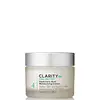What's inside
What's inside
 Key Ingredients
Key Ingredients

 Benefits
Benefits

 Concerns
Concerns

 Ingredients Side-by-side
Ingredients Side-by-side

Water
Skin ConditioningHydrogenated Polyisobutene
EmollientCetearyl Alcohol
EmollientButylene Glycol
HumectantC12-15 Alkyl Benzoate
AntimicrobialGlycerin
HumectantPentylene Glycol
Skin ConditioningOctyldodecanol
EmollientSqualane
EmollientTheobroma Grandiflorum Seed Butter
Skin ConditioningTocopheryl Acetate
AntioxidantSimmondsia Chinensis Seed Oil
EmollientPhenoxyethanol
PreservativeSodium Acrylate/Sodium Acryloyldimethyl Taurate Copolymer
Emulsion StabilisingLaminaria Digitata Extract
Skin ProtectingPolyisobutene
Glyceryl Stearate
EmollientDimethicone
EmollientParfum
MaskingPotassium Palmitoyl Hydrolyzed Wheat Protein
CleansingEthylhexylglycerin
Skin ConditioningXanthan Gum
EmulsifyingMaris Aqua
HumectantTetrasodium Iminodisuccinate
Sorbitan Oleate
EmulsifyingCaprylyl Glycol
EmollientCaprylyl/Capryl Glucoside
CleansingEctoin
Skin ConditioningHydrolyzed Lupine Protein
Skin ConditioningSodium Hyaluronate
HumectantLecithin
EmollientHydrolyzed Linseed Extract
Skin ConditioningAscorbyl Palmitate
AntioxidantPadina Pavonica Thallus Extract
Skin ConditioningSodium Benzoate
MaskingGlucose
HumectantTocopherol
AntioxidantChondrus Crispus Extract
Skin ConditioningCI 19140
Cosmetic ColorantCI 42090
Cosmetic ColorantWater, Hydrogenated Polyisobutene, Cetearyl Alcohol, Butylene Glycol, C12-15 Alkyl Benzoate, Glycerin, Pentylene Glycol, Octyldodecanol, Squalane, Theobroma Grandiflorum Seed Butter, Tocopheryl Acetate, Simmondsia Chinensis Seed Oil, Phenoxyethanol, Sodium Acrylate/Sodium Acryloyldimethyl Taurate Copolymer, Laminaria Digitata Extract, Polyisobutene, Glyceryl Stearate, Dimethicone, Parfum, Potassium Palmitoyl Hydrolyzed Wheat Protein, Ethylhexylglycerin, Xanthan Gum, Maris Aqua, Tetrasodium Iminodisuccinate, Sorbitan Oleate, Caprylyl Glycol, Caprylyl/Capryl Glucoside, Ectoin, Hydrolyzed Lupine Protein, Sodium Hyaluronate, Lecithin, Hydrolyzed Linseed Extract, Ascorbyl Palmitate, Padina Pavonica Thallus Extract, Sodium Benzoate, Glucose, Tocopherol, Chondrus Crispus Extract, CI 19140, CI 42090
Ingredients Explained
These ingredients are found in both products.
Ingredients higher up in an ingredient list are typically present in a larger amount.
Ethylhexylglycerin (we can't pronounce this either) is commonly used as a preservative and skin softener. It is derived from glyceryl.
You might see Ethylhexylglycerin often paired with other preservatives such as phenoxyethanol. Ethylhexylglycerin has been found to increase the effectiveness of these other preservatives.
Phenoxyethanol is a preservative that has germicide, antimicrobial, and aromatic properties. Studies show that phenoxyethanol can prevent microbial growth. By itself, it has a scent that is similar to that of a rose.
It's often used in formulations along with Caprylyl Glycol to preserve the shelf life of products.
This oil comes from the seeds of the desert shrub called Jojoba. It is more commonly known as jojoba oil, a non-comedogenic oil.
Jojoba oil does not contain fragrance and has many fatty-acids, making it a great soothing ingredient.
It also contains Vitamin E, a great moisturizing ingredient. Vitamin E is also an antioxidant and protects your skin against oxidative damage.
This ingredient humectant properties, meaning it helps draw moisture from the air. This helps keep your skin hydrated.
While jojoba has antibacterial properties, it is only able to kill some strains of bacteria.
Studies also show it helps in wound healing. In fact, Indigenous cultures have used jojoba as a moisturizer and to help treat burns for centuries.
Fun fact: Jojoba oil similar to natural human skin sebum, so it has a great effect on dry skin. It is also promising with helping to regulate sebum production.
Due to its fatty acid content, Jojoba oil may not be fungal acne safe. We recommend speaking with a professional if you have any concerns.
Learn more about Simmondsia Chinensis Seed OilSqualane is an emollient that helps the skin hold onto moisture. It's an oily liquid that occurs naturally in certain types of fish and plant oils.
Because squalane boosts hydration in the skin, it also comes with plenty of benefits: it is an antioxidant and can help fight free radicals and skin damage. Squalane is also found to have a detoxifying effect when applied.
Squalane comes from squalene, which occurs naturally within the sebum of our skin. It is one of the oils our skin produces to keep itself hydrated. Squalane is the hydrogenated version of squalene and has a longer shelf life.
Research shows that squalane is non-irritating (even at 100% concentration).
In general, it's a fantastic ingredient. It does a great job at hydrating the skin, and it's suitable for those with sensitive skin.
The source of squalane may impact malassezia / fungal acne. This is because olive oil derived squalane can contain impurities such as fatty acids and plant waxes. Sugarcane derived squalane is recommended for anyone with malassezia concerns.
Is squalane vegan?
This depends on the source. Squalane can be derived from both plants and animals. Most squalane used in skincare comes from plants.
Please note: the source of squalane is only known if disclosed by the brand. We recommend reaching out to the brand if you have any questions about their squalane.
Read more about squalene with an "e".
Is squalane an oil?
Squalane is often called an oil, but it’s technically not; it’s a hydrocarbon, meaning it’s only made of carbon and hydrogen, unlike true oils which are triglycerides made of fatty acids and glycerol.
The term “oil-free” isn’t regulated, so companies can define it however they want. Some exclude all oils, while others just avoid mineral oil or comedogenic oils.
While some people avoid oils thinking they cause breakouts, the right kind of oil (or oil-like ingredient like squalane) can actually help balance and hydrate your skin. It’s worth testing out simple oils or squalane to see what works best for your skin.
Learn more about SqualaneWater. It's the most common cosmetic ingredient of all. You'll usually see it at the top of ingredient lists, meaning that it makes up the largest part of the product.
So why is it so popular? Water most often acts as a solvent - this means that it helps dissolve other ingredients into the formulation.
You'll also recognize water as that liquid we all need to stay alive. If you see this, drink a glass of water. Stay hydrated!
Learn more about Water